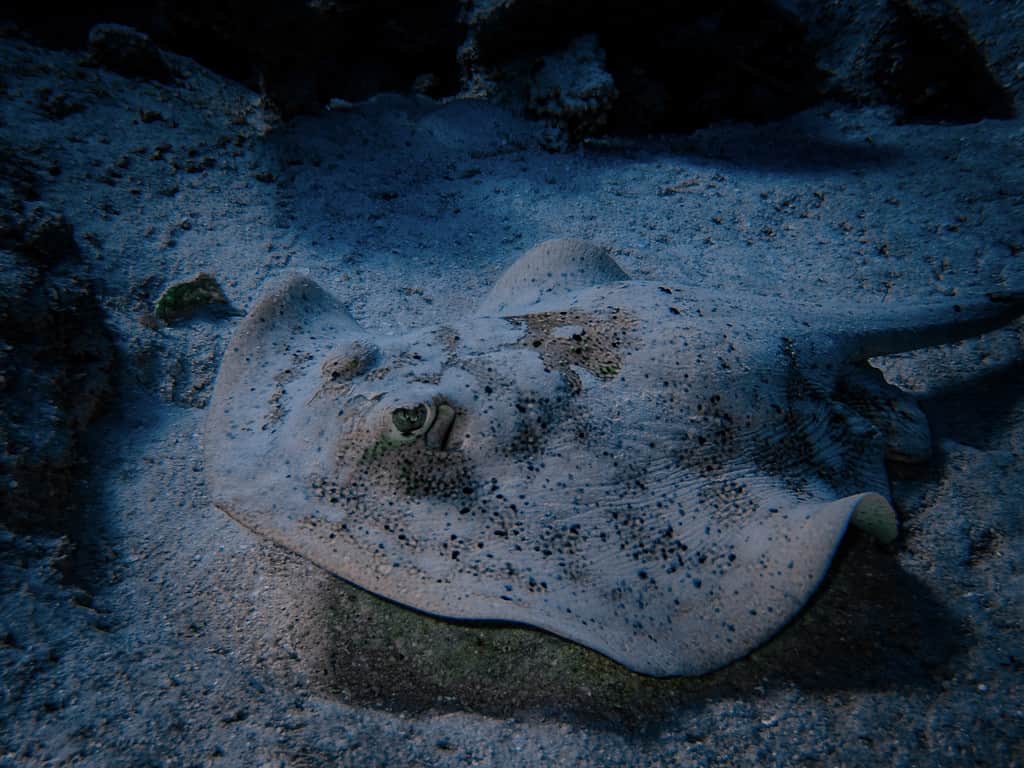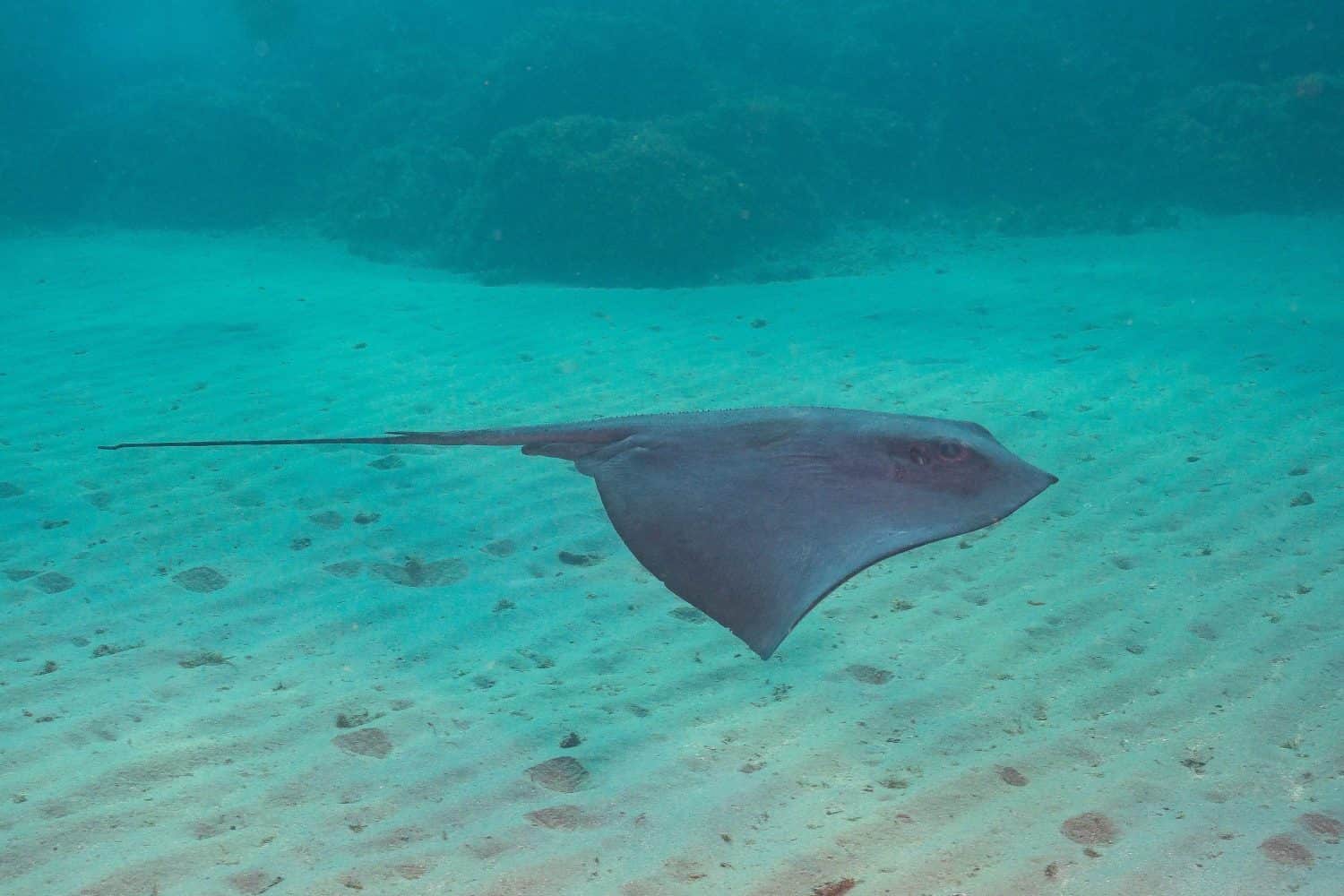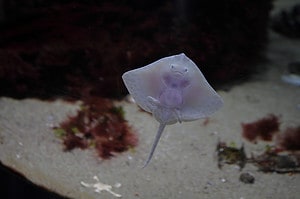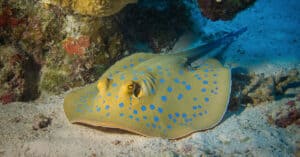For many, stingrays are an instantly recognizable marine animal, gliding near the floor of the ocean with their flattened bodies and elongated, narrow tails. These fish, along with skates, sharks, and sawfish, are known as elasmobranchs and belong to the Elasmobranchii subclass of cartilaginous fish. They primarily live throughout coastal tropical and subtropical oceanic waters around the globe, although a few species roam the open ocean and some even inhabit freshwater systems. Currently, scientists categorize over 200 species of stingrays into about 29 genera.
Among the approximately 200 species of stingrays that exist globally, scientists have observed several hunting strategies. In this guide, we’ll provide an overview of their diet, the various tactics stingrays use to capture prey and delve into the specific strategies and diet of four unique species.
Read on to learn more.
Diet and Hunting Strategies of Stingrays: An Overview
Regarding habitat and hunting strategies, there are three primary types of stingrays: oceanic benthic, freshwater benthic, and pelagic species. They can utilize a range of hunting strategies to capture prey. Some species are particularly active at night, while others tend to continuously feed throughout the day.
Stingrays are highly electroreceptive fish, meaning they can receive information about the world around them through electricity. Most species of stingrays feature rows of sensory cells across their face, called the ampullae of Lorenzini, which allows them to detect weak electrical fields generated by potential prey. This is especially useful for stingrays that hunt prey buried in sediment.

Stingrays are highly electroreceptive, able to hunt prey by detecting their weak electrical fields.
©Erin Westgate/ via Getty Images
Oceanic Benthic
The majority of stingray species are bottom-dwelling (benthic). Oceanic benthic stingrays play a huge role in the ocean’s health as they hunt near and along the ocean floor. By stirring up these sandy areas while searching primarily for small invertebrates, benthic stingrays create aerated and essential micro-habitats for phytoplankton and zooplankton. These microscopic organisms form a crucial component of the entire ocean’s food web. Without the tiny zooplankton and phytoplankton, the ocean as we know it would not exist.
Freshwater Benthic
Currently, there are about 35-40 freshwater stingray species classified, the majority of which live in the Amazon River. They are one of the few cartilaginous fish to live in freshwater environments. Like their oceanic relatives, benthic stingrays that live in freshwater ecosystems primarily hunt crustaceans and other invertebrates. They use similar hunting strategies as their oceanic counterparts.
Pelagic Stingrays
There is currently one extant species of pelagic (open ocean-dwelling) stingray, Pteroplatytrygon violacea. These stingrays travel across the open ocean and utilize a distinct hunting strategy from their benthic relatives to capture free-swimming prey. While spotted eagle rays are benthopelagic rays that do contain a venomous, barbed stinger on the base of their long tail, these rays are distinct from stingrays, although they are closely related.
Diet and Hunting Strategies of 4 Amazing Stingray Species
Below, we’ll dive into the specific hunting strategies and diet of the pelagic stingray and three other unique species of oceanic and freshwater benthic stingrays.
Diet and Hunting Strategies of Stingrays: Atlantic Stingray (Dasyatis sabina)
A benthic, oceanic species, the Atlantic stingray (Dasyatis sabina) inhabits coastal waters of the western Atlantic Ocean from the Chesapeake Bay to southern Florida and the Gulf of Mexico. Able to tolerate low salinity, the Atlantic stingray can inhabit estuaries and lagoons.
This stingray features a brown/yellow disc-shaped body with a whip-like tail. They can grow up to about 14 inches wide and feature a spade-like, pointed snout. A single venomous barbed spine sits near the base of the tail and is used in defense. This stingray belongs to the whiptail stingray family (Dasyatidae).
Atlantic stingrays hunt along the bottom of shallow waters, typically no deeper than 20 feet. Often, Atlantic stingrays use an ambush strategy called “tenting” to capture their meal. This strategy involves pressing their pectoral fins against the sea floor and using their head to create a suction force that pulls prey underneath them and into their waiting jaws.

The Atlantic stingray uses a strategy called “tenting” to suction buried prey into its jaws.
©Johan-Holmdahl/ via Getty Images
Largespot River Stingray (Potamotrygon falkneri)
A freshwater, benthic species, the largespot river stingray (Potamotrygon falkneri) is native to the Rio Paraná and Rio Paraguay basins in Brazil, Paraguay, and Argentina. The largespot river stingray reaches a width of up to 20 inches and a total length of about 36 inches. This freshwater stingray belongs to the Potamotrygonidae family.
A 2009 study reported three main hunting strategies of Potamotrygon falkneri: stirring, charging, and picking.
The stirring method is commonly seen in oceanic relatives, in which benthic stingrays undulate the margins of their disc-like bodies to stir up the river bottom substrate. This tactic uncovers hidden prey, such as aquatic worms, mollusks, crustaceans, and small fish.
Charging describes the hunting strategy in which the largespot river stingray charges upon prey concentrated in the shallows of the river. There, they quickly hover over their targets and pull them into their mouth.
Finally, researchers less commonly observed Potamotrygon falkneri plucking prey, such as aquatic insects, that were floating on the surface of the water or adhered to a substrate on the surface. The study suggests that this picking strategy may be restricted to the primarily freshwater stingrays of the Potmatrygonidae family.

Researchers observed three distinct hunting strategies of the largespot river stingray: stirring, charging, and picking.
©tgrey fox / CC BY-SA 2.0 DEED – License
Diet and Hunting Strategies of Stingrays: Pelagic Stingray (Pteroplatytrygon violacea)
The sole member of its genus in the Dasyatidae family, the pelagic stingray (Pteroplatytrygon violacea) is an ocean-going stingray. It employs a set of hunting strategies distinct from its benthic relatives. Rather than hunting primarily invertebrates along the floor of the ocean or river, the pelagic stingray preys upon free-swimming invertebrates and bony fish. Their diet includes planktonic crustaceans, jellyfish, octopus, shrimp, and small ocean-going fish such as mackerel. Typically, the pelagic stingray lives and hunts up to 330 feet deep. Occasionally, these stingrays are sometimes reported at depths up to 780 feet.
In contrast to the more disc-like shape of many of its benthic relatives, the pelagic stingray features triangular pectoral fins. As such, it moves more like a bird flapping its wings. Instead of hovering over the floor of the ocean to stir up prey hiding in sediment, the pelagic stingray uses swiftness against its pelagic prey. While most benthic stingrays feature notably straw jaws for crushing crustaceans, the pelagic stingray has weaker jaws with sharper teeth meant for slicing its free-swimming prey. Often, the pelagic stingray hunts upside down, pulling prey into its mouth with its wing-like pectoral fins.

The pelagic stingray hunts free-swimming prey, including small pelagic fish such as mackerel.
©Jesus Cobaleda/Shutterstock.com
Diet and Hunting Strategies of Stingrays: Australian Whipray (Himantura australis)
The Australian whipray (Himantura australis) lives in shallow coastal waters and estuaries at depths up to 135 feet. It occurs off the coast of northern Australia, western Australia, Cook Island, northern New South Wales, and Papua New Guinea. This lovely species features a pointed snout, rounded but distinct pectoral fins, and dense dark-brown spots, speckles, and reticulations.
This benthic stingray forages primarily in sandy and muddy areas. There, it can employ its preferred hunting strategy of creating what researchers call “feeding pits”.
Researchers engaged in a recent study comparing the feeding behaviors involving 125 individual stingrays belonging to one of two species: the Australian whipray and the cowtail stingray (Pastinachus ateri). They found that Australian whiprays created three times as many feeding pits over the study. The results demonstrated the hunting preference of the Australian whipray for stirring up sediment. By doing this, they create small pits on the muddy and sandy ocean floor to uncover hiding prey. Scientists typically refer to this behavior as foraging. Foraging stingrays often feed throughout the day, rather than engaging in ambush attacks in low-light conditions.

Researchers discovered that the Australian whipray’s preferred method of hunting is to forage by creating feeding pits in muddy and sandy areas of the ocean floor.
©Coughdrop12 / CC BY-SA 4.0 DEED – License
The photo featured at the top of this post is © Rich Carey/Shutterstock.com
Thank you for reading! Have some feedback for us? Contact the AZ Animals editorial team.






